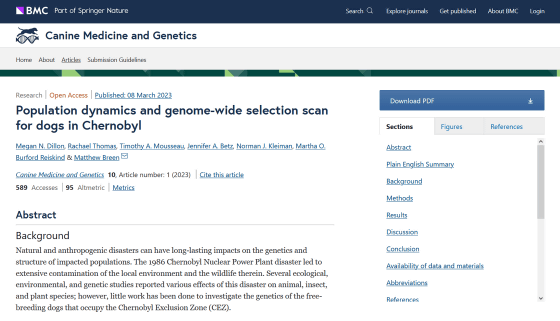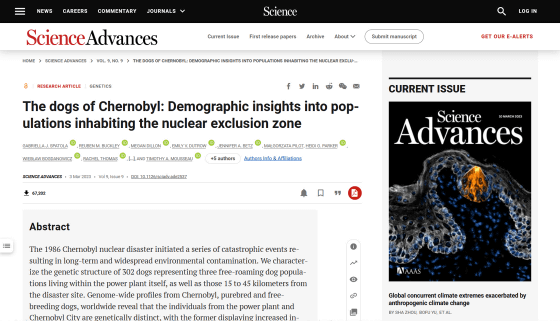Suggests that dogs living in the exclusion zone of the Chernobyl nuclear power plant may be adapted to the effects of radiation

In 1986,
Population dynamics and genome-wide selection scan for dogs in Chernobyl | Canine Medicine and Genetics | Full Text
https://doi.org/10.1186/s40575-023-00124-1

Dogs Living in Chernobyl Have Adapted with DNA Mutations, Study Suggests
https://www.vice.com/en/article/93k97d/dogs-living-in-chernobyl-have-adapted-with-dna-mutations-study-suggests
In the exclusion zone contaminated by radiation from the Chernobyl nuclear power plant accident, scientific research has often been conducted on the effects of radiation and exclusion measures on the remaining flora and fauna. However, it is said that almost no surveys targeting stray dogs left by former residents have been conducted so far.
These stray dogs sleep in radiation-contaminated railway stations and urban ruins, where they are fed by cleaning workers, nuclear power plant workers and the occasional tourist . Since 2017, the Clean Futures Fund, an international organization that supports people working in the restricted area of the Chornobili nuclear power plant, administered rabies vaccines to stray dogs and castrated them. At this time, blood samples were collected from dogs living in various places within the restricted area, and multiple research teams used these samples to perform genetic analysis.

Led by Megan Dillon, a Ph.D. student at North Carolina State University, the team found a group of dogs living in the immediate vicinity of the Chernobilli nuclear power plant, and another inhabiting a ruined city 10 miles from the plant. We investigated genetic differences in the groups.
Dillon's research team said, ``Wild animals in Chernobilli have been the subject of ecological and genetic studies so far, but more than 500 dogs living around the Chernobilli nuclear power plant and the city of Chernobilli have been studied. Little is known about the genes of these dogs, which expanded in the decades after the accident and are partly composed of the offspring of pets left behind by the 1986 evacuation. It can be considered, ”he said.
The research team used blood samples taken in 2018 and 2019 to identify a population of stray dogs living in the immediate vicinity of the Chernobyl nuclear power plant and an abandoned city of Chernobyl, about 10 miles from the plant. Genes were compared across populations.
As a result of the analysis, it was found that the two groups were not far apart in distance, and although both were hybrids such as
``It is interesting to see how well the offspring of abandoned dogs have adapted to survive and thrive in such extreme environments,'' said the researchers. 'Understanding the genetic and health effects of this type of toxic environmental stressor will improve our understanding of how these types of adverse environmental stressors affect human health.'

In addition, the research team of Elaine Ostrander et al. of the National Human Genome Research Institute of the United States also used samples collected by the Clean Futures Fund to analyze the genes of stray dogs living in the off-limits area of the Chornobilli nuclear power plant. rice field. Half of the stray dogs that analyzed the samples lived in the immediate vicinity of the nuclear power plant, and the rest lived in the city of Chernobyl, the polluted station, and the city of Slavutic , which is outside the exclusion zone more than 40 km away. .
The dogs of Chernobyl: Demographic insights into populations inhabiting the nuclear exclusion zone | Science Advances
https://doi.org/10.1126/sciadv.ade2537

The Dogs of Chernobyl Reveal the Genomic Aftermath of a Human-Made Environmental Disaster - DNA Science
https://dnascience.plos.org/2023/03/09/the-dogs-of-chernobyl-reveal-the-genomic-aftermath-of-a-human-made-environmental-disaster/
In Chernobyl's Stray Dogs, Scientists Look for Genetic Effects of Radiation - The New York Times
https://www.nytimes.com/2023/03/03/science/chernobyl-dogs-dna.html
As a result of the analysis, it was shown that the dogs living around the nuclear power plant are genetically different from other dogs, and that cross-group cross-breeding is almost non-existent. It has been pointed out that the lack of mating between groups may be due to the physical security barriers around the power plant.
``We were struck by the fact that the two groups were almost completely differentiated and remained isolated for quite some time,'' said co-author Timothy Mousseau of the University of South Carolina. increase.
Related Posts:







